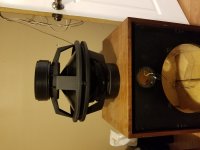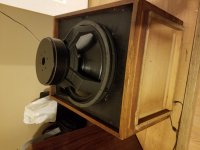If you use a driver like this in a couple cubic feet it would still be movable:
Peerless by Tymphany STW-350F-188PR01-04 15" High Power Subwoofer
Peerless by Tymphany STW-350F-188PR01-04 15" High Power Subwoofer
The bit of wood with holes in will bend more easily than one without holes. Maybe 60% more.Here is another thought. We all know that if we add a panel across the inside of a speaker that is loaded with holes, it will be just as strong but will take up less space. The load is in plane of the panel.
What if I glued the same panel to the inside of the wall of the sub-woofer cabinet, what it be as stiff as a solid piece of wood? It would still take up less space, but would the area of the cut out affect the stiffness and with the cutout there would still be more area available.
I think the holes should really be of different sizes when used typically. Looking at baffle step talks, some holes between 50 and 150mm would be resonant within the audible range. I'm just skirting round the idea though, I have not looked in any detail. I avoid multiple use of the same dimension though. Often using a jigsaw for such jobs, knowing that being a bit rough will reduce the area of parallel surfaces.
edit: It's the subwoofer forum. Doh.
These arrived yesterday. 60lbs of drivers. I have to cut 3/4" larger sround so they will fit the holes.
Very nice.
Did you decide to add braces?
Grant.
Im going to cut the whole hole today and start laying out the bracing. My buddy from back home owns a saw mill and is sending me 44" feet od 1.5"×1.5" oak*for the bracing
That'll help.
I've run a half dozen pieces just in from the driver hole from front to back using PL glue inside and a screw front and back and that supported the driver a lot better. That PL construction glue is strong stuff and you could probably get away easily with no screws.
Grant.
I was only thinking side to side. Front to back makes sense too. The way you discribe it when the front to back braces are in place, the front or back panel are locked in place....is the right?
Yep. I figure the front back motion from the driver is a lot higher than side to side.
I never thought of using ready-rod for bracing. Neat idea.
Thanks for posting that.
the little Karlson cabinets (KK-Audio, Transylvania Power, Acoustic Control, etc.) all used 3/8" all-thread rod to brace the "wings". It ran all the way from the wings through the inner baffle to the back and reduced modulation effects as even 3/4" Russian birch plywood would flex in this application.
3/4" dowel rod and closet poles are pretty good too

3/4" dowel rod and closet poles are pretty good too

K15 made a good sub for John Tucker of Exemplar - it was re-tuned down to around 30Hz with 2 3" PVC elbows, loaded with low fs Altec, then boosted like a 6th order reflex. I tried it with an Altec 416Z - very articulate - perhaps due to Altec's motor and low moving mass. That said, I can't guess how much the front chamber would come into play for subwoofer use.
with the old K15 vent spec of 4.5" wide by 9" talle, there's plenty of room to mount the new vents on a board right over the stock vent. I think Exemplar used "street-el" with flange on one end. I used regular elbow with both flranges and it fit nicely. Exemplar said the modified Karlson was the only sub at the time which would keep up with their hybrid (A7- like) horn.
looks like roughly 28Hz with this old SpeakerWorkshop plot

with the old K15 vent spec of 4.5" wide by 9" talle, there's plenty of room to mount the new vents on a board right over the stock vent. I think Exemplar used "street-el" with flange on one end. I used regular elbow with both flranges and it fit nicely. Exemplar said the modified Karlson was the only sub at the time which would keep up with their hybrid (A7- like) horn.
looks like roughly 28Hz with this old SpeakerWorkshop plot

Last edited:
So this brings me to some cabinets I want to have made, and maybe a matching table. I have a rustic table, made of pine, LOVE the table and the look BUT every little thing scratches it.WHY NOT SPRUCE PLYWOOD?...Spruce has by far the highest stiffness-to-weight ratio of any of the woods commercially used for ply, and it's almost 1/3 the cost of BB...Birch is a little bit stiffer, but also MUCH heavier.)
- How do birch and spruce compare for surface hardness/scratchability?
- It was a bit typo'd but I think you said you felt 1/2" spruce ply was as stiff as 3/4 baltic?
Because to make large cabinets, which would go on casters to spread apart for wider staging when nobody is home, I'd sure consider thinner ply and bracing/damping. Maybe modify the drivers so I could fill the enclosures with specially absorptive Jello-or Jello Biafra ha ha.
"How do birch and spruce compare for surface hardness/scratchability?"
Spruce is softer.
Try a google search like "Janka Rating timber" or "Janka rating X", where X is the species of interest.
Most of the woods with high hardness are rare / exotic / exploitative / not available as plywood.
...so if you want a hard (scratch proof) surface that looks like timber, I'd recommend strand woven bamboo.
You can laminate this onto a normal ply substrate. That gives the nice finish with a bit less expense (thick bamboo panels are rather expensive).
Spruce is softer.
Try a google search like "Janka Rating timber" or "Janka rating X", where X is the species of interest.
Most of the woods with high hardness are rare / exotic / exploitative / not available as plywood.
...so if you want a hard (scratch proof) surface that looks like timber, I'd recommend strand woven bamboo.
You can laminate this onto a normal ply substrate. That gives the nice finish with a bit less expense (thick bamboo panels are rather expensive).
I did not know that existed, so thanks!Janka Rating"
- Status
- This old topic is closed. If you want to reopen this topic, contact a moderator using the "Report Post" button.
- Home
- Loudspeakers
- Subwoofers
- how important is bracing???

